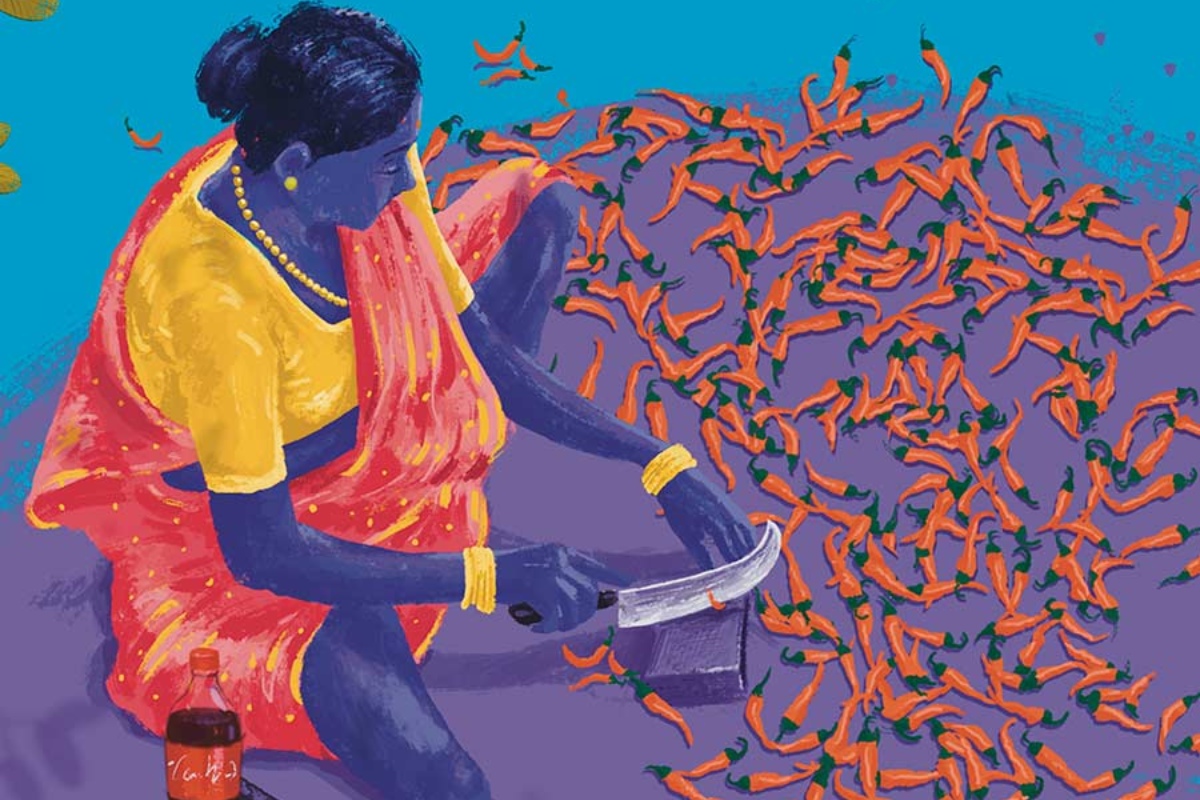The subcontinent of India is well known for its spices. It boasts a long history of trading with the ancient civilization of China and Rome. Today, our spices are the most sought-after worldwide, considering their exquisite texture, aroma, taste, and medicinal value.
India has the most prominent domestic spices market globally. Traditionally, Indian spices are grown in small landholdings. The country is also the most significant consumer, producer, and exporter of spices. Notably, India produces over 75 of the 109 spices varieties listed by the ISO, International Organization for Standardization, and makes up almost half of the world’s spice trading (1).

Some Flavoursome Indian Spices Data
- In FY 2020, India exported spices worth over 3.62 billion USD.
- In FY 2021, top importers of Indian spices include Hong Kong, the US, UAE, Australia, UK, and Canada.
- India exported over 4 billion USD spices between April 2020 and March 2021, and in March 2021 alone, India exported over 448.77 million USD.

- In April 2021, the value was 398.50 million USD.
- In FY 2020, till December 2019, ginger export had the highest growth of 47%, followed by cardamom with 31%, and cumin with over 14% (2).
- As per the Indian Spices Board, India makes for about 30% of the globe’s pepper production, 35% of ginger, and 90% of turmeric.
- Among all Indian states, Kerala is at the top of the chart since it produces about 96% of pepper, 53% cardamom, and 25% of ginger in the country.
- With the production of chili and turmeric, Andhra Pradesh leads the chart with 49% and 57%, respectively. Meanwhile, Rajasthan is the largest producer of cumin, 56%, coriander, 63%, and fenugreek, 87% (3).

It is also worth pointing out that the surge in the domestic demand for spices has kept their prices high, especially for pepper and chill (4, 5). Even though it is advantageous for businesses as producers can make money from the local market, producers are losing out in the international markets by keeping the prices high.
The country produces whole and processed spices and exports the majority of the processed spices to Europe and the US. For instance, Indian pepper producers process them into white pepper, green pepper, and oleoresin before exporting them to European nations. They also carry out sorting, grading, and standardization of spices to improve their quality and earn more revenue.
As per industry experts, despite economic slowdowns in some countries amid the coronavirus pandemic, India has kept the charms of its spices and will continue to be the top producer for several years to come (6).
The Outlook of the Spices Market is Pretty Zesty
As per the official sources from the Indian Brand Equity Foundation, during 2017-18, India exported a massive 1.08 billion KG of spices of several types to different nations around the globe. During the same period, the total export market value stood at 3.11 billion USD.
A report on Spices Market 2021-2026 by IndustryARC (7) predicts that between 2019 to 2025, the spices market will continue to witness growth with a 4.80% CAGR because of the increasing demand for spices with the expanding urbanization trend.
In general, spices have several applications, including sauces, bakery products, frozen foods, beverages, dressings, package foods, and more. It has made the food segment one of the most promising areas in the spices market. There are expectations that it would grow at 5.10% CAGR during the same period. Apart from the food and beverage industry, spices’ end users also include pharmaceuticals and cosmetics.

The Major Growth Drivers
Expansion of Globalization
Developed nations like the United Kingdom and Canada have become more accepting, and with increased immigrants, globalization has reached a new pinnacle (8).
Let’s look at India itself for an example. The country is a leading producer and consumer of spices worldwide and the world’s largest diaspora, with more than 30 million Indians living overseas. A consistent migration and expansion of people from different ethnicities lead to composite culture and sharing of culinary cultures. Ultimately, it also impacts the spices market.
The Spices market has experienced massive growth worldwide over the past few decades because of the new cuisines using new spices. It has been a noticeable growth driver for the market, and as per experts, it will remain one.
Food and Beverage Industry
The food and beverage industry is the most significant end-user of spices worldwide. With the surge of disposable income, the urban population and the working class, in general, are more willing to eat in restaurants and experience different cuisines.
Frozen and packaged food also uses spices to make food more appealing while preserving it for a long time. It has contributed significantly to the overall market growth of spices and would define its direction in the upcoming years (9).
The Transformation of the Indian Spices Industry and the Impact of Pandemic
Even though the food and grocery market didn’t face the same horror as the non-essential retailers during the coronavirus pandemic, the industry too was influenced by the pandemic and the subsequent lockdown. Although things have started to normalize, the fear of the infection is still there, and businesses across the FMCG segment are compelled to make significant overhauls in how they make and retail their products.
Similar to other markets, the Indian spices industry was no exception. It has also witnessed significant disruption over the last few months. Consequently, businesses operating in the industry were also compelled to streamline their brand portfolio and innovate in all aspects of their operations, from product development to marketing and in-store services. To appeal to consumers, they have now become more discerning than ever.
Similar to other industries, the spice industry has also started to rely on automated processes to enhance food safety and address labor issues (10).
“To keep up with today’s demand for hygiene and safety, we have implemented a 100% contact-less packaging system. We have also installed a computerized tracking system for finished goods,”
says Vikek Pathak, Rakesh Group’s CEO (11).
While people worldwide are trying out new products, the onus lies on retailers and brands to grasp what their consumers are looking for and serve them accordingly. Likewise, the leading spice producers are also working to come up with innovative products that would find relevance in the new normal.
According to Dheeraj Jain, a Director of Kwality Foods (12),
“We have launched a range of Healthy Muesli to cater to the growing demand for immunity-boosting products. We are the first Indian firm to launch muesli with ginger, turmeric, and honey. Besides that, we have also launched a range of muesli with no added sugar.”
Moreover, businesses are also compelled to ramp up their marketing efforts and leverage digital platforms to connect with people.
Raman Khanna, the CEO of UVR Natural Foods Pvt Ltd (13), says that
“we are investing heavily on social media platforms such as Instagram, Facebook, Twitter, and LinkedIn to stay connected with ozr consumers. Moreover, we are also collaborating with several food bloggers and influencers in addition to educating people about our products via our YouTube Channel.”
Notably, after the coronavirus outbreak, there was a massive uptick in the usage of Indian spices globally. As per the ASSOCHAM dipstick (14), the spices exports were increased by 34% in rupee terms and 23% in dollar terms in June last year. The study further highlights that,
“The Indian spices exports went up by 23% to 3.59 million USD in June last year, from the 292 million USD in the same month last year. Quite a contrary to a 12.41% decline in the country’s overall merchandise exports during the same period. Thanks to forex’s strong point, spices exporters raked in even better results in the domestic currency, which increased to 34% to 2721 crore INR in June 2020 from 2,030 crore INR in the comparative month a year before.”
Nonetheless, the massive uptick in the Indian spice industry has led to explosive opportunities for businesses and entrepreneurs who are looking to make good returns with low investments.
The Sweet Spices Business Scope
In India, starting a spices business is lucrative as the country has an abundance of spices and the demand for them is never likely to go down. Businesses can work directly with spice producers and sell them in retail, wholesales, and even online (15, 16).
Opportunities
Besides the obvious, there is an abundance of opportunities for those looking to profit from the lucrative market. Including:
Regulatory and Licensing: Whether small-scale or large-scale, spice businesses need several registrations and licenses like MSME, FSSAI license, Import Export Code, FPO Regulations, BIS Certification, Agmark Certification, and more. It may not be feasible for small producers and sellers to do them all by themselves, and you can help them with all legal procedures.
Making/Selling/Maintaining Machinery and Equipment: Businesses need multiple machines to process whole and raw spices and transform them into powered and variety of spices. You can help them choose machines with the latest technologies and offer period maintenance services.
Eco-friendly Fertilizers and Pesticides: One of the biggest challenges of the spices industry today is sustainability. While they have increased some grounds for a more sensible future with IPM and MRL, there is still much to be done. You can help offer eco-friendly agrochemicals, desirable results for spices producers with minimum damage to the environment.
Fintech for Small-scale Spices Producers: Small-scale farms make a tremendous amount of the overall spice economy in India (17). Fintechs can come into play here and help those overlooked little-scale farmers with their budgetary troubles.
Marketing: Another issue the spice market faces is the lack of proper marketing and advertisements. You can offer businesses innovative marketing strategies to encourage consumers worldwide to produce spices and utilize them for different purposes, including culinary, medical, and cosmetics (18).
DIY Uses of Spices: Cosmetic industry dominantly uses spices for its organic properties. Herbs like sage and rosemary are popular in the essential oils market (19). Spices like vanilla, clove, cinnamon are also used in the perfume and cologne industry (20). You can also spread their DIY usage for cosmetics and medicinal properties via DIY kits, newsletters, tutorials, etc.

Homemade Sauces and Spices Mixture: Even small-scale businesses can make a good profit when it comes to the spices industry. You can start an online store or list your business in popular marketplaces like Amazon to sell your products. It can include products such as chili sauce, pepper sauce, garlic sauces, etc., or spices mixture like pizza seasoning, taco seasoning, curry powder, Chinese spices mixes, Mexican seasoning, etc.
Besides, you can also start selling subscription boxes of spices with unique or new offerings of your spice blend or dried herbs samples with each subscription box. You can also combine recipe books, how-to guides on how to use individual spices, different ways to use sauces, and more.
Wrapping Up
Similar to other industries across the world, the spice industry in India is also making rigorous innovations in their existing businesses with increasing reliance on technology for manufacturing, product conceptualizing, optimized business management protocols, and marketing.
As the industry is compelling with the new normal, it has also led to an explosion of new challenges and lucrative business opportunities.











![Read more about the article [Funding alert] D2C fashion brand Bewakoof raises $4M from IvyCap Ventures](https://blog.digitalsevaa.com/wp-content/uploads/2021/03/Funding-1587044486257-300x150.png)